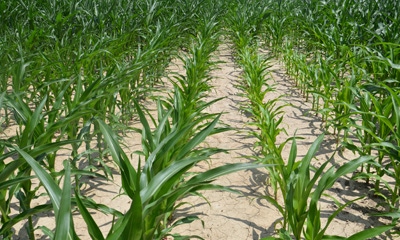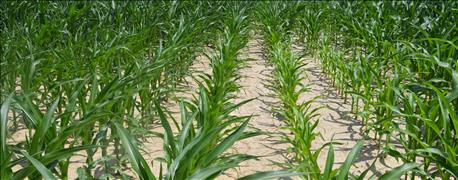July 7, 2016

Recent conditions have brought a change of pace to the year. It seems like all spring we were looking for a dry spell to plant, and now we are in one in many areas. The dry weather will have a good effect on the root systems of our corn and soybeans, but we may see a few concerns come from it.
Here are my thoughts about the possibility of seeing signs of soil compaction, plus two other things to watch for right now.
1. Corn that was planted in less-than-ideal conditions has some issues.

SOIL COMPACTION IS REAL: The effects of soil compaction tend to show up more when it dries out, especially in corn.
We may have some trouble with root establishment. These plants in a dry spell will show some stress and stunting. Many of us are starting to see corn “roll up.” Remember, corn rolls as a protection method to help slow transpiration through the daytime hours. If corn is rolled during the day and unrolls at night, it's trying to conserve water.
In comparing corn hybrids, some will roll sooner than others as a protection method. This doesn’t mean one is more drought-tolerant than another. That is based more on genetics. Be sure to walk the areas where corn is rolled and determine why it is showing signs of stress. Dig roots and compare them to roots of unrolled plants. Is there a difference, or is it truly dry soils?
2. Nodulation should have kicked in for soybeans.
We saw a majority of the soybeans in southern Indiana reach V3, or the third trifoliate stage, in late June. Some turned yellow and looked nitrogen-deficient. This was caused by the plant transitioning to getting nitrogen from nodulation. This yellowing is short term, but drier ground may prolong it a little longer than normal.
3. Spraying season goes on and on.
The season for spraying just keeps going, and weeds just keep getting bigger. If you are still spraying, scout the field for weed pressure first. Make sure you are targeting all weeds. As we start to dry out, remember that some weeds will be harder to kill as they slow their growth to conserve water. Run labeled rates and be sure to check growth stages. Also, if you are planning to plant cover crops and you’re still spraying residuals, be sure they will not affect your cover crop seeding this fall. Check herbicide labels to find this information.
Gauck is a team sales agronomist for Beck’s. He writes from Decatur County.
You May Also Like




